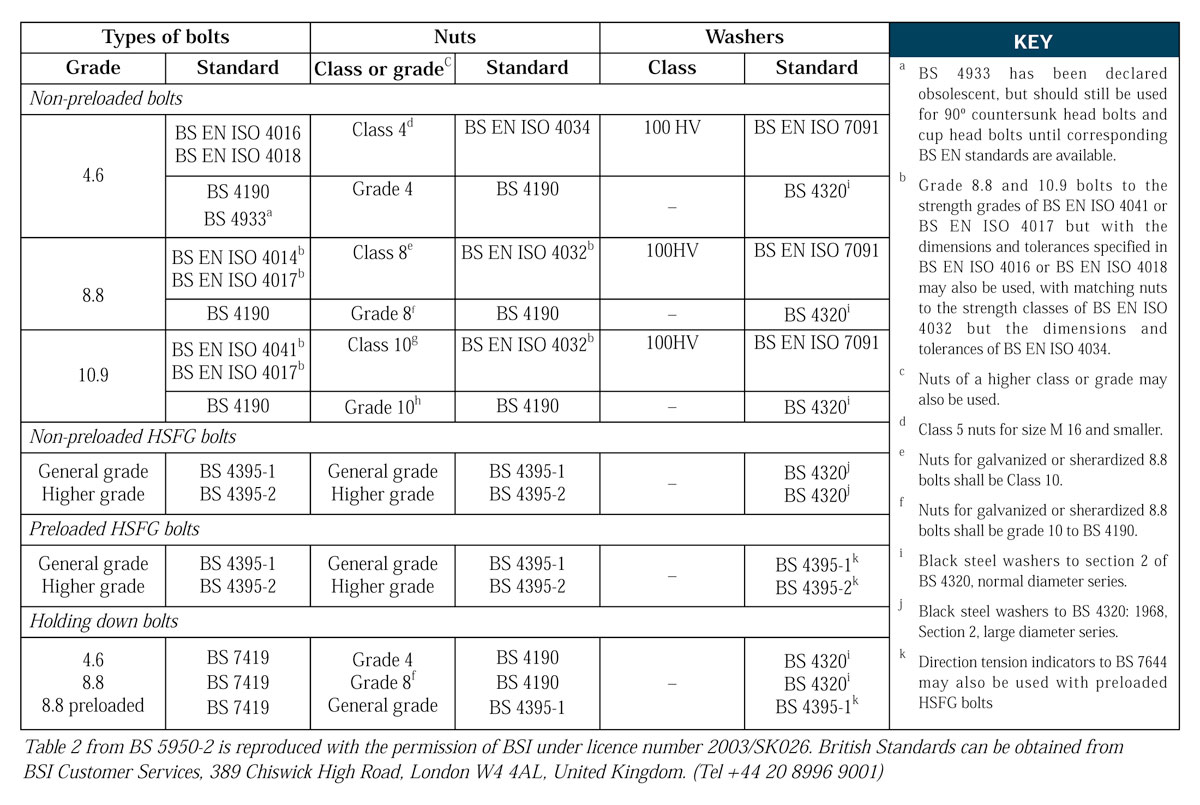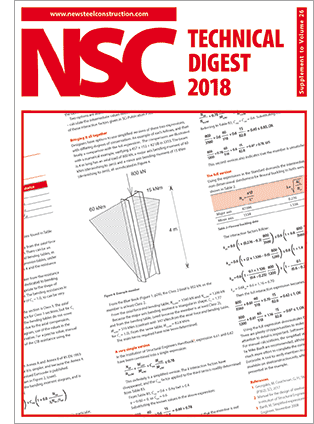Technical
AD 265: Matching bolts, nuts and washers
From time to time questions arise concerning the appropriate combinations of bolts, nuts and washers to specify when used in structural steelwork. The SCI has provided Advisory Desk notes AD 189, 193 and 226 which included a table that outlined the matching assemblies. However, a new table appeared in BS 5950: Part 2, when it was revised in 2001, similar to those that had previously appeared in AD notes 189 and 226. This new table from BS 5950-2: 2001 is reproduced below and supersedes the tables give in AD notes 189 and 226.
The key differences between Table 2, BS 5950-2: 2001 and the tables in AD 189 and AD 226 are the deletion of BS 3692 from the table and the removal of the limitations concerning BS 4190. It should be noted though, that both BS 3692 and BS 4190 were revised in 2001.
For many years non-preloaded bolts in the UK were ordered to either BS 3692: 1967 or BS 4190: 1967. BS 4190: 1967 contained the requirement for bolt grades from 4.6 to 6.9 while BS 3692: 1967 covered the whole range of bolt grades. Bolts to BS 4190: 1967 were manufactured to normal dimensional tolerances and they were used in 2mm or 3mm clearance holes dependent on diameter. Bolts to BS 3692: 1967 used the normal head and nut sizes but the bolt shank was made to a closer tolerance. This precision enabled the bolt to be placed in a close tolerance hole. However, as the overwhelming majority of holes used in steelwork connections are clearance holes it became customary to order non-preloaded bolts of grades 8.8 and 10.9 to BS 3692: 1967 manufactured to the normal dimensional tolerances from BS 4190: 1967. Clause 3.2.2 in BS 5950-1: 1990 acknowledged this fact.
With the introduction of BS EN standards for bolts, both BS 3692: 1967 and BS 4190: 1967 were superseded by BS EN standards and declared obsolescent (but not withdrawn). This is reflected in AD 189 and AD 226. However, industry never fully accepted these new BS EN standards and continued to order non-preloaded bolts in the customary fashion. Following requests from industry and changes to ISO standards which left both BS 3692: 1967 and BS 4190: 1967 behind in technical developments terms it was decided to reinstate them since both were so widely used. Hence BS 3692 and BS 4190 were revised in 2001, bringing both into line with BS EN ISO 898-1 for mechanical properties. Thus BS 3692: 1967 and BS 4190: 1967 have now been superseded and withdrawn.
Both BS 3692: 2001 and BS 4190: 2001 should be consulted for a full appreciation of all the changes following these revisions. BS 4190: 2001 now contains the full range of bolt grades from 4.6 to 10.9 for non-preloaded bolts manufactured to normal dimensional tolerances for use in clearance holes. Thus there is no need to incorporate BS 3692: 2001 into Table 2, BS 5950-2: 2001. BS 3692: 2001 also contains the full range of bolt grades from 4.6 to 10.9 but with the bolt shank to a closer tolerance. This standard must still be specified on the very rare occasions that “precision bolts in close tolerance holes” are required but these occasions are so rare that BS 3692: 2001 has not been incorporated into Table 2, BS 5950-2: 2001.
On a final note, referring to AD 263 Limitations of bolt Grades to BS 5950-1 and Eurocode 3, it should be noted that the highest bolt grade covered by both BS 3692: 2001 and BS 4190: 2001 is Grade 10.9. This is because bolts with a higher grade than 10.9 are considered to have insufficient ductility to be used safely in normal structural connections.













